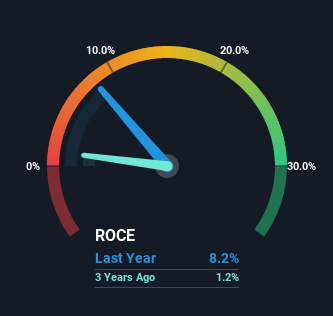- Canada
- /
- Oil and Gas
- /
- TSX:BNE
Bonterra Energy (TSE:BNE) Is Looking To Continue Growing Its Returns On Capital
If you're looking for a multi-bagger, there's a few things to keep an eye out for. Firstly, we'll want to see a proven return on capital employed (ROCE) that is increasing, and secondly, an expanding base of capital employed. Basically this means that a company has profitable initiatives that it can continue to reinvest in, which is a trait of a compounding machine. With that in mind, we've noticed some promising trends at Bonterra Energy (TSE:BNE) so let's look a bit deeper.
Return On Capital Employed (ROCE): What Is It?
For those who don't know, ROCE is a measure of a company's yearly pre-tax profit (its return), relative to the capital employed in the business. To calculate this metric for Bonterra Energy, this is the formula:
Return on Capital Employed = Earnings Before Interest and Tax (EBIT) ÷ (Total Assets - Current Liabilities)
0.082 = CA$63m ÷ (CA$934m - CA$163m) (Based on the trailing twelve months to June 2022).
So, Bonterra Energy has an ROCE of 8.2%. In absolute terms, that's a low return and it also under-performs the Oil and Gas industry average of 19%.
See our latest analysis for Bonterra Energy

While the past is not representative of the future, it can be helpful to know how a company has performed historically, which is why we have this chart above. If you want to delve into the historical earnings, revenue and cash flow of Bonterra Energy, check out these free graphs here.
The Trend Of ROCE
Bonterra Energy has not disappointed in regards to ROCE growth. The data shows that returns on capital have increased by 556% over the trailing five years. That's not bad because this tells for every dollar invested (capital employed), the company is increasing the amount earned from that dollar. In regards to capital employed, Bonterra Energy appears to been achieving more with less, since the business is using 31% less capital to run its operation. Bonterra Energy may be selling some assets so it's worth investigating if the business has plans for future investments to increase returns further still.
On a side note, we noticed that the improvement in ROCE appears to be partly fueled by an increase in current liabilities. The current liabilities has increased to 17% of total assets, so the business is now more funded by the likes of its suppliers or short-term creditors. It's worth keeping an eye on this because as the percentage of current liabilities to total assets increases, some aspects of risk also increase.
In Conclusion...
In the end, Bonterra Energy has proven it's capital allocation skills are good with those higher returns from less amount of capital. And since the stock has fallen 46% over the last five years, there might be an opportunity here. With that in mind, we believe the promising trends warrant this stock for further investigation.
One more thing, we've spotted 4 warning signs facing Bonterra Energy that you might find interesting.
While Bonterra Energy isn't earning the highest return, check out this free list of companies that are earning high returns on equity with solid balance sheets.
Valuation is complex, but we're here to simplify it.
Discover if Bonterra Energy might be undervalued or overvalued with our detailed analysis, featuring fair value estimates, potential risks, dividends, insider trades, and its financial condition.
Access Free AnalysisHave feedback on this article? Concerned about the content? Get in touch with us directly. Alternatively, email editorial-team (at) simplywallst.com.
This article by Simply Wall St is general in nature. We provide commentary based on historical data and analyst forecasts only using an unbiased methodology and our articles are not intended to be financial advice. It does not constitute a recommendation to buy or sell any stock, and does not take account of your objectives, or your financial situation. We aim to bring you long-term focused analysis driven by fundamental data. Note that our analysis may not factor in the latest price-sensitive company announcements or qualitative material. Simply Wall St has no position in any stocks mentioned.
About TSX:BNE
Bonterra Energy
A conventional oil and gas company, engages in the development and production of oil and natural gas in Canada.
Very undervalued with mediocre balance sheet.
Market Insights
Community Narratives





